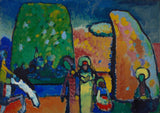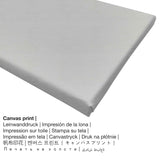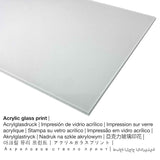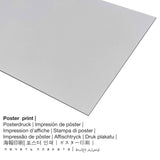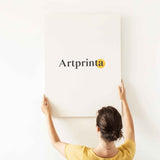Wassily Kandinsky, 1909 - Ọmụmụ maka imeziwanye nke mba. 2 (March olili ozu) - ọmarịcha nka nka
Ụtụ gụnyere. Mbupu gbakọrọ na ndenye ọpụpụ.
Product nkọwa
na 1909 Wassily Kandinsky kwuru made the 20th century piece of art. The painting had the following size: 49,8 cm x 69,8 cm , 50 cm x 69,5 cm and was painted with the Usoro oil on cardboard. The original artwork has the following text as inscrption: "1909 Wassily Kandinsky began many of his more important new plants in three categories divide into "impressions," "improvisations" and "compositions". Under "impressions" he understood "impressions of external nature," the "compositions" a deliberate, rational as well as emotional painting, which according to their own laws organized itself (see. Table 29, 30). The group of "improvisation", however, Kandinsky described as "mostly unconscious, mostly suddenly resulting expressions of processes internal character as impressions of the 'inner nature'". The "Study of Improvisation 2 (Funeral March)", whose final version is in the Moderna Museet, Stockholm, is one of the first created and numerous other improvisations that Kandinsky to 1913 numbered in a continuous series. Before an unreal, unreal reminiscent of landscape elements scenery three Russian-looking female characters are at the leading edge gathered in the middle, another sits slightly removed their right, while a rider from coming in left on a white horse in the picture. A touch of symbolism is above the enigmatic scene. As later in a series of "improvisation" characterizes the motive treasure of the fairytale, Russian images even here, despite the formal changes the whole character of this "impression of inner nature." The sub-title designation "Funeral March" indicates less an act but rather the image the mood. In its muted, portentous character, the "Image with Kahn" from 1909 or earlier "Three Women" are roughly comparable, giving in compositional terms as in terms of individual elements clues for the interpretation of "Improvisation 2". Thereafter can the deep blue strip forward as separating the pieces on a ramp identify than water, the two large colored blocks behind them are mountains or cliffs, the round annealed form between them a cloud. But these block-like forms, in particular the right to the bright orange and light blue 'back', seem to turn into organic forms, not least due to the sophisticated color that meets their domestic fields with restless life. In a similarly low-slung stance, the schematic female figures and the on-coming riders from the left remain. is with him appears a central figure of the imagination Kandinsky, often encountered, especially in the group of "improvisation" and not least the symbolic figure of the "Blue Rider" are. All figures are cut off by the edge of the image, which obscures their meaning. Apparently Kandinsky studied in the "improvisations" for anti substantive expressions. The Verunklärungen of form and content are steps on the way to a new, autonomous reality of the painting.". It belongs to the digital art collection of Städtische Galerie im Lenbachhaus und Kunstbau München. This modern art masterpiece, which is in the ngalaba ọha is included with courtesy of Wassily Kandinsky, Studie zur Improvisation Nr. 2 (Trauermarsch), 1909, Oil On Cardboard, 49,8 cm x 69,8 cm , 50 cm x 69,5 cm, Städtische Galerie im Lenbachhaus und Kunstbau München, https://sammlungonline.lenbachhaus.de/objekt/studie-zur-improvisation-nr-2-trauermarsch-30019275.html. : Städtische Galerie im Lenbachhaus und Kunstbau München. Na mgbakwunye na nke ahụ, nhazi nke mmepụta dijitalụ dị na odida obodo format ya na oke onyonyo nke 1.4: 1, nke pụtara na ogologo bụ 40% ogologo karịa obosara.
Ngwaahịa ị nwere ike iburu
Na nhọrọ ndọpụta ngwaahịa ị nwere ike ịhọrọ nha na ihe ị họọrọ. Nhọrọ ndị a dị maka n'otu n'otu:
- Akwụkwọ mmado ebipụtara (akwa akwa akwa): The Artprinta poster is a printed cotton canvas with a granular structure on the surface. The poster print is suited for framing the art print in a customized frame. Please keep in mind, that depending on the size of the poster print we add a white margin of something between 2-6cm round about the work of art in order to facilitate the framing.
- Mbipụta iko acrylic na-egbuke egbuke (ya na mkpuchi iko n'ezie): The print on acrylic glass, which is sometimes referenced as a fine art print on plexiglass, will convert your favorite original work of art into brilliant décor. Your artwork is custom-made with modern UV direct print machines.
- Kwaaji: A printed canvas, which should not be confused with a canvas painting, is an image printed on a canvas fabric. It makes the unique effect of three dimensionality. Canvas prints are relatively low in weight, which means that it is easy and straightforward to hang the Canvas print without additional wall-mounts. Therefore, canvas prints are suitable for all kinds of walls.
- Mbipụta nke aluminom: Aluminium Dibond prints are metal prints with an impressive depth. The Direct Print on Aluminum Dibond is the perfect introduction to art reproductions on alu. The bright and white parts of the work of art shimmer with a silk gloss, however without any glare. Colors are bright and vivid in the highest definition, details of the print are crisp and clear, and the print has a a matte look that you can literally feel.
metadata nka nka
| Aha onye nka: | Wassily Kandinsky kwuru |
| Nationality: | Russian |
| Ọrụ: | onye na-ese ihe |
| Mba onye si: | Russia |
| Nkewa onye nka: | omenkà nke oge a |
| Nwụrụ na afọ nke: | 78 afọ |
| A mụrụ: | 1866 |
| Afọ nwụrụ: | 1944 |
| Nwụrụ na (ebe): | Neuilly-sur-Seine, France |
Data ndabere gbasara ọrụ nka mbụ
| Aha nka: | "Study for improvisation no. 2 (funeral march)" |
| Nhazi: | sere |
| Okwu nche anwụ: | nkà nke oge a |
| Nhazi oge: | 20th narị afọ |
| Emepụtara na: | 1909 |
| Ogologo afọ nka nka: | ihe karịrị 110 afọ |
| Ọkara nke ihe osise izizi: | mmanụ na kaadiboodu |
| Akụkụ nke ihe osise izizi: | 49,8 cm x 69,8 cm, 50 cm x 69,5 cm |
| Ederede ihe osise izizi: | 1909 Wassily Kandinsky began many of his more important new plants in three categories divide into "impressions," "improvisations" and "compositions". Under "impressions" he understood "impressions of external nature," the "compositions" a deliberate, rational as well as emotional painting, which according to their own laws organized itself (see. Table 29, 30). The group of "improvisation", however, Kandinsky described as "mostly unconscious, mostly suddenly resulting expressions of processes internal character as impressions of the 'inner nature'". The "Study of Improvisation 2 (Funeral March)", whose final version is in the Moderna Museet, Stockholm, is one of the first created and numerous other improvisations that Kandinsky to 1913 numbered in a continuous series. Before an unreal, unreal reminiscent of landscape elements scenery three Russian-looking female characters are at the leading edge gathered in the middle, another sits slightly removed their right, while a rider from coming in left on a white horse in the picture. A touch of symbolism is above the enigmatic scene. As later in a series of "improvisation" characterizes the motive treasure of the fairytale, Russian images even here, despite the formal changes the whole character of this "impression of inner nature." The sub-title designation "Funeral March" indicates less an act but rather the image the mood. In its muted, portentous character, the "Image with Kahn" from 1909 or earlier "Three Women" are roughly comparable, giving in compositional terms as in terms of individual elements clues for the interpretation of "Improvisation 2". Thereafter can the deep blue strip forward as separating the pieces on a ramp identify than water, the two large colored blocks behind them are mountains or cliffs, the round annealed form between them a cloud. But these block-like forms, in particular the right to the bright orange and light blue 'back', seem to turn into organic forms, not least due to the sophisticated color that meets their domestic fields with restless life. In a similarly low-slung stance, the schematic female figures and the on-coming riders from the left remain. is with him appears a central figure of the imagination Kandinsky, often encountered, especially in the group of "improvisation" and not least the symbolic figure of the "Blue Rider" are. All figures are cut off by the edge of the image, which obscures their meaning. Apparently Kandinsky studied in the "improvisations" for anti substantive expressions. The Verunklärungen of form and content are steps on the way to a new, autonomous reality of the painting. |
| Ụlọ ihe ngosi nka / mkpokọta: | Städtische Galerie im Lenbachhaus und Kunstbau München |
| Ebe ngosi nka: | Munich, Bavaria, Jamanị |
| Dị n'okpuru: | www.lenbachhaus.de |
| License: | ngalaba ọha |
| Site n'aka: | Wassily Kandinsky, Studie zur Improvisation Nr. 2 (Trauermarsch), 1909, Oil On Cardboard, 49,8 cm x 69,8 cm , 50 cm x 69,5 cm, Städtische Galerie im Lenbachhaus und Kunstbau München, https://sammlungonline.lenbachhaus.de/objekt/studie-zur-improvisation-nr-2-trauermarsch-30019275.html |
| Ebe kredit nke ọrụ nka: | Städtische Galerie im Lenbachhaus und Kunstbau München |
Ozi ndabere edemede
| Bipụta ngwaahịa: | nka nka |
| Usoro mmeghari: | dijitalụ mmeputakwa |
| Production usoro: | UV kpọmkwem obibi |
| Mmalite nke ngwaahịa a: | emepụtara na Germany |
| Ụdị ngwaahịa: | a na-achọ |
| Ngwaahịa were: | foto mgbidi, ihe ndozi ụlọ |
| Ndozi onyonyo a: | nhazi odida obodo |
| Oke akụkụ onyonyo: | 1.4: 1 - ogologo: obosara |
| Nsonaazụ: | ogologo bụ 40% ogologo karịa obosara |
| Akụrụngwa ị nwere ike ịhọrọ site na: | acrylic glass print (nwere ezigbo mkpuchi iko), mbipụta akwụkwọ mmado (akwụkwọ kwaaji), mbipụta ọla (aluminium dibond), mbipụta akwụkwọ. |
| Kanvas n'elu etiti ihe ndọtị (mbipụta akwa akwa): | 70x50cm - 28x20" |
| Acrylic glass print (nwere ezigbo mkpuchi iko) nhọrọ: | 70x50cm - 28x20" |
| Ụdị akwụkwọ mmado (akwụkwọ kwaaji) dị iche iche: | 70x50cm - 28x20" |
| Nhọrọ nha nha nke Dibond (ihe alumnium): | 70x50cm - 28x20" |
| Nhazi nke nnomi nka: | agunyeghi |
Disclaimer: We try in order to depict our products as closely as possible and to display them visually. Although, the pigments of the printed materials, as well as the printing can differ slightly from the representation on the monitor. Depending on the screen settings and the condition of the surface, not all color pigments will be printed as realisitcally as the digital version depicted here. Because our are processed and printed manually, there may as well be minor discrepancies in the motif's size and exact position.
© Nwebiisinka nke - Artprinta (www.artprinta.com)

